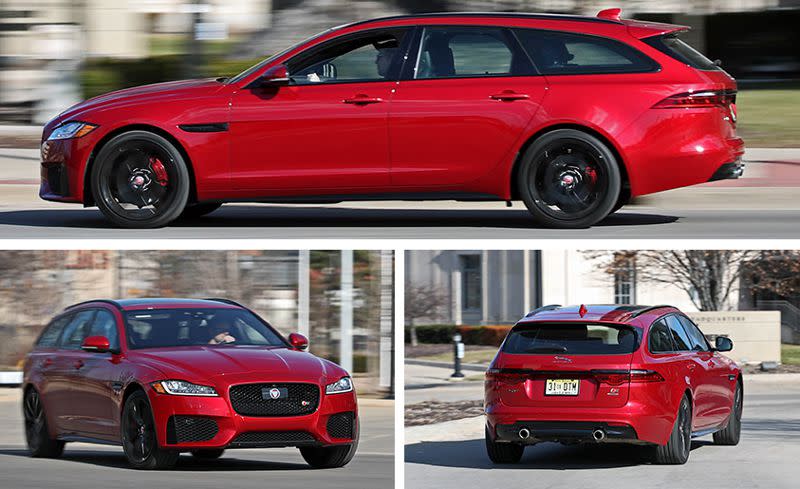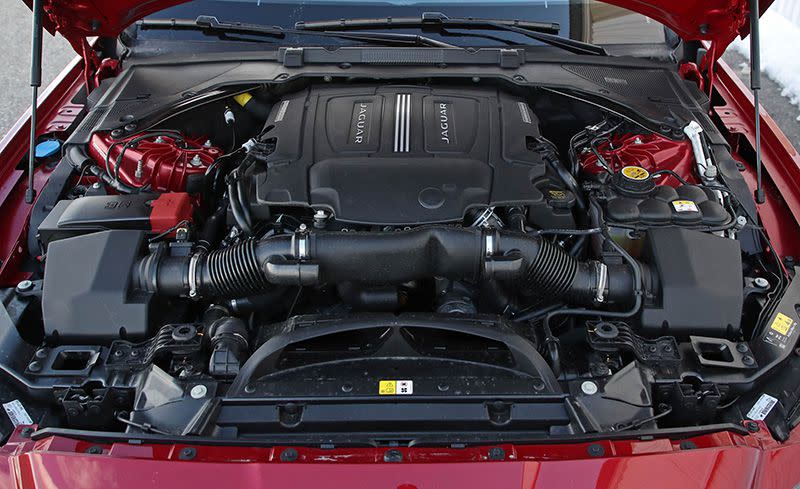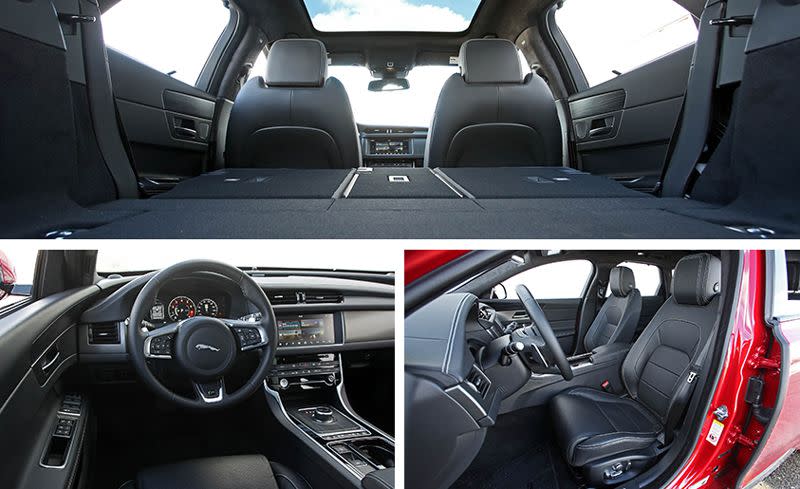Jag Wagon! We Test the 380-HP Jaguar XF S Sportbrake

In 2012, Jaguar had just three models for sale in the United States-the XF and XJ sedans, and the XK coupe and convertible-and sold only 12,000 cars here. The ensuing six years have seen Jaguar’s lineup more than double in size and its annual sales increase threefold. Now that it has its high-volume, mass-market bases covered with the F-Pace and E-Pace crossovers and the XE compact sedan, Jaguar has decided to bring a few enticing niche-market oddities to America such as the station-wagon version of the XF, dubbed Sportbrake.
The XF Sportbrake, the first Jag wagon to reach the U.S. since the forgettable X-type, leaps into a mid-size luxury-wagon segment that’s enjoying somewhat of a renaissance in the States, what with the arrival of Mercedes-Benz’s latest E-class wagon and Volvo’s V90. Even Porsche has joined in with the Panamera Sport Turismo, which admittedly is higher in price and performance.
For Those in the Know
Like these other automakers, Jaguar isn’t setting out to draw in large numbers of buyers with this new body style, but the XF Sportbrake does do a great job of catching the attention of those few wagon-loving enthusiasts sprinkled throughout the country (with a heavy concentration at Car and Driver HQ). Jaguar has created a truly beautiful shape by stretching the already gorgeous XF sedan’s roofline; to our eye, the wagon’s long, low-slung profile makes it even more of a stunner than its three-box sibling. Our test car’s combination of Firenze Red paint and optional 20-inch black wheels made for a particularly striking combination, although you really can’t go wrong with any of the Sportbrake’s color or wheel selections.
Sportiness seems to be the XF wagon’s key calling card, as the model is currently being offered in only one configuration: the top-dog S model with all-wheel drive, a supercharged 3.0-liter V-6 engine making 380 horsepower, and a few chassis tweaks to complement its athletic looks. Acceleration is swift, with the wagon matching a 108-pound-lighter XF S AWD sedan in its zero-to-60-mph and quarter-mile figures (5.1 seconds and 13.5 seconds at 105 mph), while stopping seven feet shorter from 70 mph and besting the sedan’s skidpad result by 0.01 g.
Racy but Rough Around the Edges
While the Mercedes-Benz E400 4Matic wagon hit similar numbers to the Jag in our testing (excepting its considerably better 156-foot stop from 70 mph versus the XF’s 173 feet, attributable to the Benz wearing summer tires versus the Jaguar’s all-seasons), the two wagons’ dynamic characters couldn’t be more different. The XF is far more overtly sporty, with firm damping, quick steering, and sharp turn-in that the considerably softer Benz lacks. The XF is a delight to pilot on a twisty road thanks to its eager and prompt responses, and it’s tight and satisfying in more relaxed driving, too.
As fun as the XF Sportbrake is to drive, we’d be willing to trade a small measure of its edginess for a bit more refinement. The 3.0-liter blown six, for example, produces a decidedly non-luxurious amount of noise, vibration, and harshness, even if it does have a characterful exhaust note. Wind and road noise are noticeable on the highway, as evidenced by its 71 decibels of sound at 70 mph compared with the E400’s hushed 67 decibels.
These rough edges are off-putting in a vehicle starting at more than $70,000. And despite the fact that our nearly loaded $84,815 test car was equipped with the $2860 Premium Interior Upgrade package, the cabin environment was decidedly lacking for the price. Subpar plastics mar the dashboard and center stack, switches and buttons have a low-quality feel, and the digital graphics look at least a generation behind today’s crispest automotive displays. We wouldn’t go so far as to call the XF’s cabin cheap, and a color scheme other than our test car’s dour black might add more flair, but the Jag’s insides simply don’t measure up to the inviting and plush cabins found in the V90 and the E400.
Wagon Wonders
The Jag does mostly live up to the wagon’s credo of carrying a lot of stuff. Its cargo area is deep and flat and the 40/20/40 split-folding rear seats fold easily via a convenient pair of handles in the cargo area. It held nine carry-on suitcases behind the rear seat in our testing, two fewer than the E400 and one more than the V90 (we’ll also point out that Jaguar’s own F-Pace SUV held only seven carry-ons).
This Jaguar, then, pulls off the wagon hat trick by combining a practical interior package with sports-sedan dynamics and drop-dead gorgeous looks. In our book, it’s far preferable to nearly any luxury SUV because of its undeniable elegance and exclusivity. Although the XF S Sportbrake isn’t quite as refined or luxurious as its closest rivals from Mercedes-Benz and Volvo, we still celebrate its existence because it offers a sporty and satisfying alternative in this tiny slice of the new-car market. For the first time in a while, well-to-do American wagon shoppers are spoiled for choice, and that’s worth relishing.
You Might Also Like

 Yahoo Autos
Yahoo Autos 


